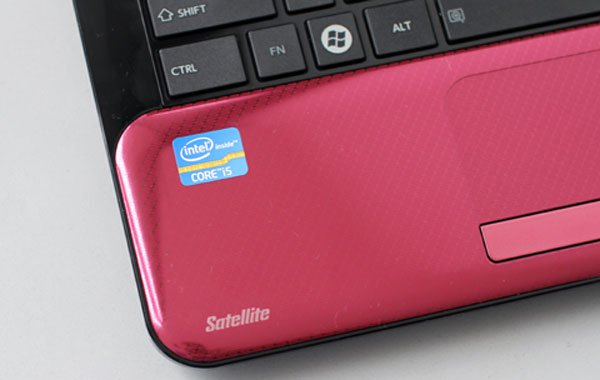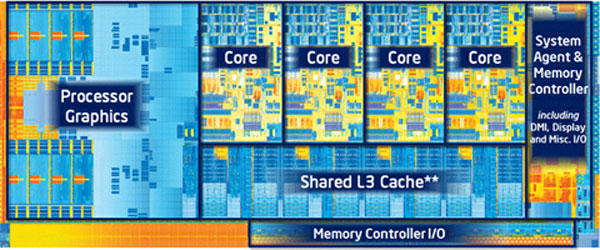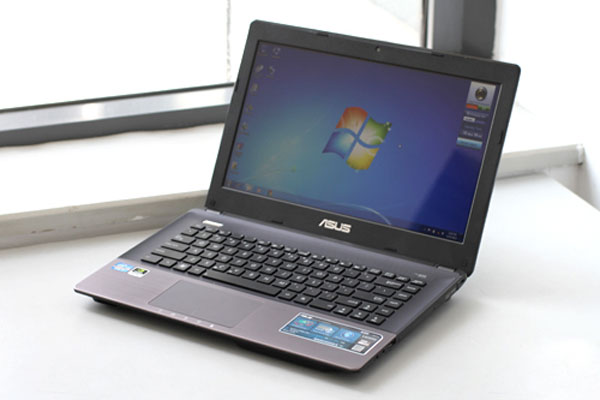Choice of Sandy and Ivy Bridge laptops
Ivy Bridge mainly upgraded the graphics processing capabilities of integrated chips, 22 nm manufacturing technology while keeping the Sandy Bridge architecture.
If compared to the time of yearly appearance, Ivy Bridge is slower than its " brother" Sandy Bridge. 2nd generation Core i chips were present at CES January 2011, while 3rd generation chips must arrive in April 2012 and sold after more than 2 months
Currently the integrated laptop models Intel Core i processor has started " docking" Vietnam market from about mid-June last but not so that the Sandy Bridge chip immediately disappeared. This is still a reasonable choice in some segments as well as consumer demand. In order to make the right decisions, users need to understand the upgrade as well as change between computers using two new chips.
Here are some noteworthy points when choosing between these two models.
Ivy Bridge is "tick", Sandy Bridge is "tock".
Intel always refers to the phrase " tick-tock " in the process of upgrading its processor every year continuously. It can be understood simply as " tick " for only one year with the normal upgrade while "tock " refers to a larger and more comprehensive upgrade. In this case, the "tick " attached to Ivy Bridge and "tock" are for Sandy Bridge.

Ivy Bridge is not a major upgrade compared to the previous generation like Sandy Bridge.
Basically, Ivy Bridge upgraded the processing process but still retains the architecture compared to the previous generation. However, the improvements in graphics processing capabilities have made Intel call this a tick + step to emphasize change. The 3rd generation Core i chips also use Sandy Bridge's production process of 22 nm compared to 32 nm to consume less power in theory.
Ivy Bridge handles faster, but only slightly.
Actual tests have shown that the performance improvement between these two chips in terms of processing speed is not much. According to PCMag, testing CineBench R11.5 renderings with Ivy Bridge Intel Core i7-3770K chip is 1.65 while Core i7-2700K (Sandy Bridge is the fastest) is 1.58 points. PCMark7's processor component score was 3,679 and 3,867 and the time in Photoshop CS5 was 2 minutes 47 seconds compared to 2 minutes 50 seconds.
Earlier announcements by Intel also showed that the new chip line is 4 to 6% faster than the previous generation.
Ivy Bridge chips consume less power.
With production precursors of 22 nm, smaller than 32 nm, Ivy Bridge is expected to consume less power than its predecessor. This is true for PCMag's tests. With two models of Core i7-2700K and the Core i7-3770K, use the Extech Datalogger program to measure power consumption. When the system is mostly in " off" with a consumption of about 71 watts, the Core i7-2700K (Sandy Bridge) processor consumes 166.5 watts of power and the Core i7-3700K is 136.3. wattt. Less levels are quite significant.
However, this does not seem to really show up on the shared laptop usage time. In some tests with the recent Ivy Bridge laptop (from 14 to 20 million VND), the battery life is still over 3 hours, equivalent to models using older chips.
Ivy Bridge supports better graphics but still not enough to play 'terrible' games .

Ivy Bridge much improved on integrated graphics chip.
The most significant change on Ivy Bridge is the graphics processing capabilities of the integrated Intel HD Graphics 4000 chip. The same is built on 22 nm process and supports 4K maximum resolution as well as 3 support. screen instead of just 2 screens as before. Overall, Ivy Bridge's GPU is up to 60% faster than Sandy's, while incorporating the actual test shadow effect, the new system can be up to 30 times stronger.
However, the fact also shows that if you want to play powerful 3D graphics games like Max Payne 3, Batman: Arkham City, The Elder Scrolls V : Skyrim, users will still need a discrete graphics card from AMD and Nvidia. Therefore, if you are a gamer, you really should consider in a range of money to choose a stronger graphics card because at this time strong configurations with Ivy chips are usually quite expensive.
Need a minimum of VND 14 million to think about the current Ivy Bridge laptop.

The current Ivy Bridge laptop has a minimum price of VND 14 million.
In the first series of laptops launched in June and maybe 2-3 months away, there will be no appearance of the Ivy Bridge Core i3 platform and all new laptops coming to Vietnam market at the moment. cost over VND 14 million (using Core i5 or Core i7 chips). Therefore, for high-end users who don't really have high demand or who use student students, Ivy Bridge laptop models aren't really suitable.
Ivy Bridge new out not too expensive, Sandy Bridge has much cheaper.
Many Vietnamese users are psychologically worried when a new product will be expensive and waiting for it to be cheaper to decide to buy. This is not really true with the new Ivy Bridge chip. The product price reduction roadmap is always in the manufacturer's dictionary but if you pay attention to the average price of about 14 to 16 million dong, it is not high compared to Sandy Bridge's equivalent of Core i5 or i7 chips only about half a year. Therefore, if there is really a need, a passion for technology or a payment for buying a big laptop, choosing Ivy Bridge is very reasonable.
Meanwhile, Sandy Bridge laptop began to gradually retreat to the cheap segment. Models using this chip even include a pretty strong discrete graphics card, which is only in the range of 11 to 12 million.
You should read it
- MSI launches GT680R gaming laptop using Sandy Bridge chip
- Sandy Bridge laptop in off season
- Trend of laptop hardware this year
- Apple equipped with Sandy Bridge processor for MacBook?
- Tips for choosing RAM for Sandy Bridge chips: Don't swing your hands over your forehead
- MSI GT680 - Sandy Bridge laptop for gamers
- Axioo is about to launch a laptop using the latest Sandy Bridge CPU
- Dell launches an ultra-thin laptop
May be interested
- Sony's new Vaio C laptop uses Sandy Bridge chip
 targeting multimedia users, vaio c laptops will have 14-inch (~ 35.6 cm) or 15.5-inch (~ 39.4 cm) screens, starting at $ 880.
targeting multimedia users, vaio c laptops will have 14-inch (~ 35.6 cm) or 15.5-inch (~ 39.4 cm) screens, starting at $ 880. - Trend of laptop hardware this year
 laptops using core i sandy bridge chips cost between 10 and 14 million, while pentium p6200 and b940 processors are mainly applied to low-cost machines.
laptops using core i sandy bridge chips cost between 10 and 14 million, while pentium p6200 and b940 processors are mainly applied to low-cost machines. - MSI GT680 - Sandy Bridge laptop for gamers
 next year, at ces (taking place from january 6 to january 9 in las vegas, nevada, usa), msi will officially launch laptop for gamers using sandy bridge
next year, at ces (taking place from january 6 to january 9 in las vegas, nevada, usa), msi will officially launch laptop for gamers using sandy bridge - Lenovo launches a laptop duo using Sandy Bridge chip
 ideapad y560p and y460p equipped with the most advanced processor options are sandy bridge core i7, lenovo's rapiddrive technology and jbl speaker system.
ideapad y560p and y460p equipped with the most advanced processor options are sandy bridge core i7, lenovo's rapiddrive technology and jbl speaker system. - Apple equipped with Sandy Bridge processor for MacBook?
 apple 'ultrathin' macbook air will be powered by intel's sandy bridge processor in june, while the macbook pro laptop will also be available next month.
apple 'ultrathin' macbook air will be powered by intel's sandy bridge processor in june, while the macbook pro laptop will also be available next month. - HP launches laptop line without causing… thigh burns!
 hp has officially introduced in vietnam market a new series of laptops with unique designs on the sandy bridge technology platform. in particular, the product line is applied cooling technology ...
hp has officially introduced in vietnam market a new series of laptops with unique designs on the sandy bridge technology platform. in particular, the product line is applied cooling technology ... - MSI launches GT680R gaming laptop using Sandy Bridge chip
 recently, msi has officially introduced the latest laptop for gamers using sandy bridge intel core i7-2630qm processor.
recently, msi has officially introduced the latest laptop for gamers using sandy bridge intel core i7-2630qm processor. - The new Macbook Air will be available in June
 parts suppliers for apple in taiwan said they have begun shipping new macbook air products using sandy bridge and thunderbolt chips since the end of may.
parts suppliers for apple in taiwan said they have begun shipping new macbook air products using sandy bridge and thunderbolt chips since the end of may. - The latest version of HP Pavilion dv6 and dv7 is released
 the dv6-7000 and dv7-7000 are all equipped with large screens, respectively, 15.6 inches and 17.3 inches, sandy bridge chips and geforce gt 650m graphics cards.
the dv6-7000 and dv7-7000 are all equipped with large screens, respectively, 15.6 inches and 17.3 inches, sandy bridge chips and geforce gt 650m graphics cards. - The HP P6-2000 desktop set costs from 7.6 million
 new product range includes 3 models p6-2010l, p6-2018l and p6-2014l equipped with intel pentium or core i3 processors on sandy bridge platform.
new product range includes 3 models p6-2010l, p6-2018l and p6-2014l equipped with intel pentium or core i3 processors on sandy bridge platform.










 Lenovo sells ThinkPad computers for students
Lenovo sells ThinkPad computers for students The first Ivy Bridge Ultrabook of Samsung in Vietnam
The first Ivy Bridge Ultrabook of Samsung in Vietnam Genuine MacBook Pro Retina to Vietnam
Genuine MacBook Pro Retina to Vietnam 7 ultrabook uses Ivy Bridge chips in Vietnam
7 ultrabook uses Ivy Bridge chips in Vietnam What upgrades for laptops with a tight budget?
What upgrades for laptops with a tight budget? Lenovo introduced G series laptops and new IdeaPad Z
Lenovo introduced G series laptops and new IdeaPad Z